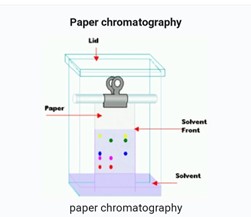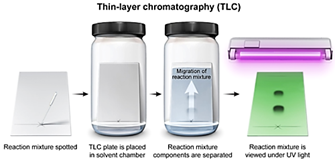Why Would One Use TLC Over Paper Chromatography?
Chromatography technique that uses paper sheets or strips as the adsorbent being the stationary phase through which a solution is made to pass is called paper chromatography. It is an inexpensive method of separating dissolved chemical substances by their different migration rates across the sheets of paper.
Although paper chromatography technique is simple and rapid, uses minimum amount of material, comparatively less expensive than other chromatographic technique it has many disadvantages. Paper chromatography is useful only for qualitative evaluation. It has limitation to separate complex mixtures.
The main differences between TLC and paper chromatography are: The principle behind thin-layer chromatography is based on adsorption. On the other hand, the principle of paper chromatography is based on partition.
TLC analysis provides better separation for the components in the mixture and more useful chromatograms than paper chromatography. However, basic TLC has many limitations in many of the important steps like application, development, derivatization and are manual, therefore we get lot of variation in the results and quantitative evaluation is ineffective. As many of the steps are manual, errors are caused by analyst as well as environmental factors like humidity.
To overcome these limitations, HPTLC technique is used, which is a modern version of TLC wherein the principals are same but the practice is fully automated and GLP/USP/EP compliant.
Unique features of HPTLC are that it is the fastest, simplest, most economical and flexible, “visible” technique which can analyse in parallel more than 100 samples. It is risk free and multiple detections can be made without repeating chromatogram. HPTLC is used for the analysis of non-volatile organic compounds such as pharmaceuticals, APIs, botanicals, forensics, foods etc. for establishing purity, impurities, fingerprint, identification, quantification and reverse engineering.
After doing single analysis, analyst gets many data points. Data is obtained at 254nm, 366nm, and in white light also after derivatization in white light or at 366nm. Spectral evaluation is also possible, as it has wide scanning range starting from 190-900nm. Nowadays, it is also possible to couple HPTLC with other spectroscopic technique like MS, IR and NMR.
HPTLC technique can also be used for detection of biologically active compounds as it can be coupled with biological assays like antioxidant activity, antimicrobial, antidiabetic activity etc.
Thus, as this technique offers many advantages for analysis of diverse type of samples and many data points after single analysis are obtained, HPTLC which is modern version of TLC is the best choice for analysis of various samples.


Anchrom Enterprises Pvt. Ltd is one of the leaders in HPTLC in food analysis. Please contact us at lab@anchrom.in for HPTLC analysis of plant extracts, drugs, ingredients in cosmetics, and forensic science.


Comments
Post a Comment